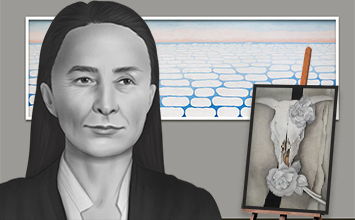This post is an updated and expanded form of an essay that I wrote in my college Women in Art class! I am excited to share some expanded and edited versions of my essays here (since I did spend plenty of time working on them, and I'd hate for them to rot away in my hard drive forever!)
 |
| Georgia O'Keeffe, Source |
“When you take a flower in your hand and really look at it, it's your world for the moment. I want to give that world to someone else. Most people in the city rush around so, they have no time to look at a flower. I want them to see it whether they want to or not.” -Georgia O'Keeffe, Quote 1
“I hate flowers- I paint them because they're cheaper than models and they don't move.”
-Georgia O'Keeffe, Quote 2
“I decided that if I paint that flower in a huge scale, you could not ignore its beauty.”
-Georgia O'Keeffe, Quote 3
Georgia O'Keeffe's art is a classic example of American art of the
early 1900s, especially with her usual subject matter of cityscapes
and close-up views of flowers. Her style of abstraction has been
lauded by artists and critics alike. Despite flowers and landscapes
being a large part of her portfolio, O'Keeffe's idea of nature is
detached, aesthetic, and almost entirely indifferent.
 |
| White Pansy, Source |
O'Keeffe's flowers and landscapes are believed to not be direct
representations of the specific objects themselves, but rather
“abstract symbols for nature... generalized representations.” The abstraction, as well as her re-visitation of flowers, caused many
men in the art world to critically accuse her of using her art to
place subliminal view of female genitalia in plain view. O'Keeffe
denied these accusations, brushing them off as simply prejudiced
remarks against women in the art world. Instead, O'Keeffe's intention
was to use nature as a catalyst to remind her viewers to slow
down. The significance of the
use of nature lies in the fact that flowers were such common things,
yet they tend to be overlooked for all their beauty. It is less
spirituality in terms of a reverence and more in terms of a personal
meditation.
Bibliography
1"Georgia
O'Keeffe Quotes." BrainyQuote. Accessed May 02, 2016.
http://www.brainyquote.com/quotes/authors/g/georgia_okeeffe.html.
2See
“Georgia O'Keeffe Quotes.” ^
3See
“Georgia O'Keeffe Quotes.” ^
4“Georgia
O'keeffe”. 1984. “Georgia O'keeffe”.The
Metropolitan Museum of Art Bulletin 42
(2). The Metropolitan Museum of Art: 3–64. doi:10.2307/3258762.

Post a Comment